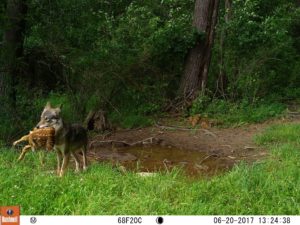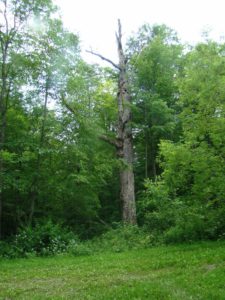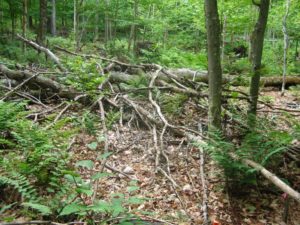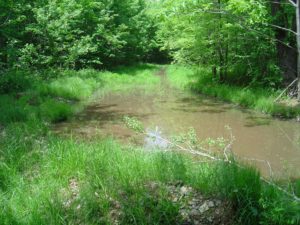Managing Woodlands to Improve Wildlife Habitat
Manipulations of the trees can create new and varied habitats for wildlife.
Most landowners own their land for a variety of reasons, though at any point in time one objective might be of more interest than other objectives. For many woodland owners, they are interested in seeing more wildlife, whether as birds or game species, or just knowing they are providing habitat. Some owners prioritize creating habitat that they know will benefit wildlife, regardless of what they personally see. As a side note, motion-sensitive trail cameras have become reasonably priced and allow you to see more wildlife. The interest in wildlife for these owners may be one of many objectives including recreation, firewood or timber.
The objectives of wildlife, timber, firewood and recreation are common, and usually compatible on the same property. This article will address some general guidelines and strategies, but numerous resources exist to expand on the concepts presented here. There are several good publications that will help landowners who want to manage their woodlands for wildlife habitat. See the reference section at the end for a couple options.
Getting Started Managing Woodlands for Wildlife
The starting point for “what should I do?” is always “what do you want?”. Knowing your objectives provides targets, and also priorities for actions. Some portions of your land may be more suitable for some objectives than others, so emphasize management actions in areas where you will receive the greatest return on your investment of time and resources. If you don’t know your objectives, think about what you want, tangible and intangible, from your property. Your spouse should go through the same exercise, and perhaps your children who are interested in the property. If there are several people involved in the ownership, it might be helpful to sort objectives that are essential, and those that are of significant interest.

A trail camera, placed strategically at an intersection of varied cover, structure and captures a reality of the interaction of predator and prey. Here, the coyote was successful, but more often they consume small mammals and have almost no impact on deer. Image courtesy of Peter Smallidge
With wildlife as a priority, it is worth keeping in mind that wildlife need food, water, cover and space. Food and water are obvious at some level, but the details about what species need what types of food and how far they travel for water are important. Cover are those parts of your woods, fields, and hedgerows that allow animals to rest, breed, hide, loaf and travel. Space allows for the freedom of a species to move within its territory without having to compete with other members of the same species for food, water and cover.
The needs of each species for food, water, cover and space are its life history traits. The life history traits for one species are covered in detail in each issue of the NY Forest Owner magazine in the column “Wild Things in the Woods.” Review your back issues, and those at www.NYFOA.org for details. There are also descriptions of life history traits in the references below, or through Internet searching.

Some trees, such as the one pictured, die from natural causes. Dead standing trees are called snags. In other cases snags can be created through chemical or mechanical girdling. Create snags in safe areas, away from trails and buildings, but a few in the woods will provide countless food, cover and space for many species. Image courtesy of Peter Smallidge
Once you know what you want, you can begin the process of planning. The resources listed below as references offer considerable guidance on the planning process. It is also possible to contact a NYSDEC forester and ask for a (free) stewardship plan, where the plan will document the full variety of your objectives and management actions you can take. You will learn more in your interaction with the forester if you go through some of these steps first, so you understand what the forester is doing.
An essential part of planning, and a common short-coming of the otherwise best laid woodland plans, is for the owner(s) to self-assess what they can bring to the effort. One way to assess your capacity is with T.I.M.E. This acronym represents Time, Interest, Money, and Energy. You will need some of each, but a shortfall in one category can often be offset from another. Be honest and realistic. Most landowners are most in need of time. Check with other woodland owners through groups such as the NY Forest Owners Association to see if your anticipation of the time required to do certain tasks is reasonable.
The planning process includes the following steps:
- Map the property. You can do this with online tools such as Google Earth Pro, and include soils information through the USDA Web Soil Survey. USGS topographic maps are also of great value. Review the link below for a ForestConnect fact sheet on these topics.
- Inventory your woods. This could be as simple as taking your map or image from step #1 and sketching areas of young versus older hardwoods, pine versus maple, scrub lands versus mature forest, springs, seeps, or whatever you have. Include trails, hedgerows, stone walls, streams, ponds, and the small woodland pools that only have water for brief periods of time. You could do a more detailed inventory; instructions are available online by searching for “landowner woodland inventory”.
- Once you have an inventory or at least a sketch of your woods, start to prioritize areas that you could manage to achieve multiple benefits. You will get ideas for what you might do by attending NY Forest Owner Association woods walks in your chapter or neighboring chapter. Cornell’s Master Forest Owner volunteers can’t provide technical guidance, but can share what they have seen on their own land and that of other owners. Request a free visit from a volunteer at www.CornellMFO.info
- In addition to the inventory of your woodlands, you need to know about the particular wildlife species that interest you. Unless you want any wildlife species, you need to learn more about your favorite birds, amphibians, reptiles, and mammals. As previously mentioned the NYFOA magazine has a column each issue on “Wild Things in Your Woods” that covers the details of many species. This is a great place to start. The references below also include details about what individual species need. The key is to start with 3 to 10 favorite species that are likely on your property, and build your knowledge.
- Now the fun starts, whatever that might be for your particular property. Your management actions should support your highest priority and most pressing objective(s). Your efforts will be specific to your land, but some examples of activities that accomplish multiple objectives follow.
Trails – After a landowner has permanently marked the boundaries of their property, the second most important task is to ensure there are trails that provide access to all areas. While many owners are willing to bushwhack without a trail, we usually spend more time in areas where we can easily travel. Trials can be as simple as bits of yarn or flagging on trees that guide the attentive eye through the woods, or can be as grand as you choose. The trail should be of sufficient width for humans or vehicles that will travel it. Also, a trail for walking can be more curvilinear than a trail for pulling your ATV logging arch or for x-c skiing. Trails don’t directly benefit wildlife, except t

Downed woody material, also called slash, is one example of cover. A variety of small mammals and amphibians would benefit from the security this provides, and access to different types of foods. Owners who harvest firewood can remove less of each tree and easily create this type of cover. Image courtesy of M. Ashdown
hat when you can see areas repeatedly you will start to imagine and visualize what you might do.
Woodland Structure – Structure is what a woodland physically looks like. Structure refers to the heights of the dominant trees, the number of trees per acre, average diameter of trees, the variability in the diameter of the trees, the fullness of the crowns, and more. Consider how you would describe one area of your property from another…that’s structure. The different types of structure often correspond to differences in the availability of food and cover, both essential to a diversity of wildlife. You can influence structure, and thus habitat diversity with simple or significant actions. These are described below as culling and “sunlighting.”
Water – In most woodlands, the single activity that

The pool shown here was created after logging and a skidder that drove through a short section of poorly drained soil. The skidder enhanced the pool with a berm of earth to hold more water a longer period of time. This 16” deep pool is almost always a certain location to find a variety of amphibians. Image courtesy of Peter Smallidge
will result in the greatest variety of wildlife is creating access to water. Adding water to your landscape adds texture. If you have beaver in the area, you can wait and see if they decide to build some dams on your property. If you have a harvest of logs, you can likely ask the logger to expand some wet spots to encourage trapping water for periods of time. You can also design a build a pond, or repair a pond that exists but has become over-grown.
Culling – In the normal course of the growth of a woods or forest, there are more trees than can be supported by the sunlight that is available. As the woods grow and the average tree diameter increases by one inch, approximately 20% of the trees must die. Tree death will happen regardless of our efforts, so the option is for the owner to decide which trees will die, or let natural processes decide. Pick trees that don’t support your ownership objectives and safely fell or girdle those trees. Culling can include the more traditional practices of thinning or crop tree management, with retention of considerable amount of woody slash on the ground for wildlife cover. Culling could also include creating snags, which are standing dead trees, and are important as homes for a variety of wildlife species, particularly birds.
Sunlighting – The term “daylighting” is often used in regards to providing sunlight to forest roads so that they dry more quickly after rain and snow. I use the term “sunlighting” here to illustrate the value in making sure there is sunlight on the forest floor to stimulate the growth of herbaceous and woody plants that serve as food and cover for wildlife. Sunlight to the forest floor might be increased with a canopy opening at a cluster of culled trees, or might be something more expansive such as a one acre patch clear cut. Owners can personally open areas of a 0.25 to 3 acres as a personal project, if they have the tools and knowledge to work safely. Thus, sunlighting can occur as a continuum on your property from clusters of small gaps to larger openings. The more of the woody slash you leave behind, the greater the benefit for wildlife. It is also possible, if not advisable, to retain several live stems of nice trees in the clearing as perches and as future timber trees. Realistically, these openings will be used by deer which will preferentially browse, likely over-browse, the desired species and leave invasive shrubs in their wake. Be alert to these conditions and treat the problem as it develops. You might want to fence some areas to exclude deer. Unless you leave enough slash to significantly offend your aesthetic sensibilities, you likely will not exclude deer.
Planting – Many rural woodlands also have a few acres of open meadow or old pasture. These grasslands are important in and of themselves. In some cases, with an abundance of open acreage, you may want to establish some dedicated wildlife plantings on some portion of your open acreage. Pick native species that have specific benefits as food or cover for the wildlife species on your “most wanted” list. The three key aspects of a successful planting are to: (i) select a species suited to the soil, (ii) prepare the site so that competing vegetation is controlled, and (iii) protect the plant from damage by deer and rodents.
In many ways, woodlot management is synonymous with wildlife management. Manipulations of the trees create new and varied habitats. By planning for specific and desirable changes in the vegetation, owners can influence the success and abundance of wildlife species. Plan thoroughly and work safely.
This article originally appeared on www.ForestConnect.com, a program project of Cornell University Cooperative Extension and the NYS Department of Natural Resources. Support for ForestConnect is provided by the Cornell University College of Agriculture and Life Sciences and USDA NIFA through McIntire-Stennis and the Renewable Resources Extension Act.

